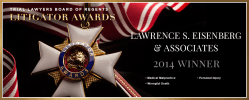$7,000,000 Birth Injury Case
Liability in Irvine Personal Injury Cases
The general definition of liability is at fault for the incident which caused the injured plaintiff their injuries and damages. Liability is established through evidence, which can be witness statements or testimony of witnesses who saw what transpired that caused the injuries and damages.
For example, in a motor vehicle accident case, a traffic collision report can provide information and details that the Irvine personal injury attorney can utilize to establish that the adverse negligent driver is at fault or liable for the injuries of the plaintiff.
In all types of personal injury cases, liability must first be established by admissible evidence, such as witness testimony and documentary evidence, before the injured plaintiff can prove up their injuries and damages. The plaintiff has the burden of proof, by a preponderance of the evidence, to first prove liability and then damages the experienced personal injury lawyer in Irvine will know what evidence is required to win the case.
Factors That Make Liability Difficult to Establish
If the injured plaintiffs can be deemed to be partially at fault, by contributing to the occurrence of the event that caused the injuries, this can make it more difficult to establish liability. This is known as negligence when the plaintiff contributes to the occurrence of the incident. So for example, in a premises liability case where the plaintiff is walking in a retail store and slips and falls on an apparent defect in the floor, the retail store can be at fault as the owner/operator of that particular premises occasion.
In this example, if the plaintiff who is injured as a result of the fall, was wearing high heel shoes and walking too fast, this conduct may have contributed to the fall. The plaintiff can be considered to be comparatively negligent and the insurance company will emphasize these facts in an attempt to diminish the value of the claim. The personal injury attorney must evaluate all of these factors and be able to counteract the arguments of the insurance company, even though there may be facts that are adverse to the client, the experienced attorney will argue that the defect in the floor was the greater factor which caused the client to fall and become injured in the first place.
Evidence Used to Establish Liability
Evidence that is used to establish liability or fault would include testimony from an eyewitness to the incident, such as car accident or slip and fall premises liability case. A witness can give a written statement signed under penalty of perjury or testify under oath at a deposition, arbitration or trial. Evidence in the form of documents could include a traffic collision report or documents related to the manufacture of a defective product. An experienced personal injury lawyer will analyze your case and obtain the proper evidence to prove your case and protect your rights. The ultimate goal is to obtain the highest amount of compensation for the client.
Finding The Responsible Party
With regard to who is responsible for the particular personal injury incident that caused injuries to the plaintiff, the attorney has to establish fault or liability. In order to do that the particular facts of the incident need to be evaluated as soon as possible after the occurrence. For example, in a motor vehicle accident you need to look at the collision itself, who rear ended the plaintiff causing injuries, who was the negligent driver who did not have their brakes adequately maintained so they were in proper order.
Another example would be a landlord of a particular residence or apartment building who did not have the handrails checked and when the plaintiff was walking up the stairway, and grabbed on the handrail and since there was a failure to maintain it properly, it came loose from the wall causing the plaintiff to fall and sustain injuries.
There are a few examples of personal injury cases where all of the facts must be investigated and fully analyzed to determine who are the negligent parties who are at fault and responsible.
Common Situations Where Negligence Can Cause Injury
Any situation where the adverse party does not take reasonable and proper care while conducting themselves can result in negligence causing injuries. This can happen while driving a motor vehicle or maintaining a residence or business location. Whenever the defendant is negligent and their conduct causes injuries and damages, the injured party can seek appropriate compensation from the negligent party.
An example of reckless conduct is when an intoxicated driver causes a motor vehicle accident. The conduct of consuming too much alcohol which led to the impairment is considered reckless conduct. When such intoxication causes a car accident, the impaired negligent driver can be responsible to play the damages of the injured party including for the injuries, medical expenses, loss of earnings and pain and suffering and emotional distress. However, the negligent defendant who was also reckless (the intoxicated driver) can be compelled to pay punitive damages.
Punitive damages are imposed when the defendant engages in egregious conduct, since such additional damages are meant to deter this type of conduct. The experienced personal injury attorney will allege punitive damages as a strategical method to exert leverage on the insurance company and the lawyer for the defendant in order to obtain the best result for the client.










